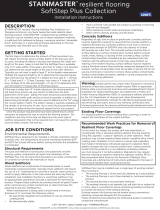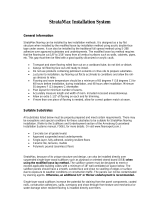Page is loading ...

The Book of Answers
FREQUENTLY ASKED QUESTIONS

Frequently Asked Questions | 2
faqs
Fighting the urge to start in the corner?
We get it. It does feel like the natural place to start, but the Floorigami experts at Shaw Floors have tested this process
in small spaces, large spaces and everything in between, and we’ve found starting in the corner leaves more room for
error when you reach the end of your install. Tiles can become unevenly spaced, and sometimes you’re left with a weird
gap along one wall. We want to make sure your new Floorigami space is picture perfect, so we’ve worked hard to refine
our instructions to do just that. Starting in the center allows you to first measure your space so you don’t end up cutting
every tile at the end of your room to fit. Starting in the center and installing half of the room first provides you with multiple
alignment points at all times, to ensure those lines are straight. Our biggest tip here is to lay out your entire Floorigami floor
first, whether that’s a wall-to-wall room or an area rug, before you start to peel and stick.
Having difficulty sticking tiles to your subfloor?
UNFINISHED WOOD SUBFLOOR
Every subfloor is unique. Some make it easy for Floorigami tiles to stick and some make it more difficult. It depends on the
age of the subfloor, the pad that was under the carpet and a number of other variables. Before you start your install, test
peeling and sticking one of your tiles to the subfloor. If it’s having trouble sticking, you might need to prime your subfloor
first. A latex floor primer will do the job and once primed, you can start installing tiles right away, just give it a little under
an hour to dry first.
PAINTED SUBFLOOR
When installing over a painted subfloor we recommend the paint be fully adhered. If the paint is peeling, the paint should
be removed and proper floor preparation should take place. The paint should also be checked to make sure that it is not
toxic. A 24 hour adhesive bond test should be conducted to assure an adequate bond. Should the bond test fail, the paint
surface should be sanded in order for the adhesive to adhere properly.
Looking to hide those seams a little more?
Some Floorigami styles are designed to slightly show the seams, but for those plush styles, all you need is a screwdriver.
Once your tiles are down, simply lift the edges of the two adjacent tiles by placing a screwdriver under the seam and then
pull the fibers up as you run the screwdriver down the seam. Just be cautious of the screwdriver making contact with your
hard surface below so you don’t cause any damage. Another simple thing to do is vacuum the entire room. This lifts the
fibers and helps blend those areas where the tiles meet.

Frequently Asked Questions | 3
faqs
Replacing tiles to fit perfectly back in place?
When it’s time to peel up a tile to either clean or replace it, just keep in mind the direction of the arrows from your original
install and ensure you place the tile back with arrows going the same direction. Depending on the tile type, it might be a snug
fit to place the tile back in place. Simply peel back the edges of the adjacent tiles as you slide the new tile back in place for a
perfect fit.
Struggling with a tricky cut?
CUTTING AROUND A VENT
Remove the vent plate and place the tile, fiber facing up, over the open vent. Once the tile is in position and lined up with the
adjacent tiles, cut through the vent with your carpet knife. Cut out the vent with the fibers up. It can be a little smaller than the
actual vent opening. Your vent plate will help hide any imperfections.
CUTTING AROUND A CORNER
When it’s time to cut up against the corner, flip your tile over, fibers facing down, toward the floor. Mark your tile just like you
would up against the wall. Use your carpet knife to mark where the tile needs to be cut, then cut from the back.
Not finding your answer?
Visit floorigami.com and chat now,
or call us and speak with a Floorigami
expert at 1-844-742-7429.
still stuck?
/



